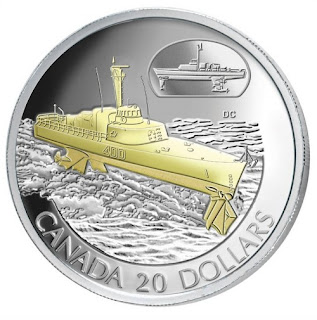Canada 20 Dollars Silver Coin 2003 HMCS Bras d'Or
Transportation Series
Obverse: Right-facing profile of Her Majesty Queen Elizabeth II by artist Dora de Pédery-Hunt, along with the year and face value.
Lettering: ELIZABETH II D • G • REGINA 2003.
Engraver: Dora de Pédery-Hunt.
Reverse: The coin showcases the HMCS Bras d'or (FHE 400).
At the end of the Second World War, the Royal Canadian Navy knew it had to update its warships if it hoped to succeed in anti-submarine warfare. Taking one of Alexander Graham Bell's clever inventions, researchers developed an innovative hydrofoil ship that could surf accross water at high speed to intercept any nuclear-powered submarine. A change in defence policy forced the Bras d'or into retirement without ever having entered military service.
Lettering: CANADA 20 DOLLARS.
Engraver: Bonnie Ross.
Mintage: 31997.
Composition: 92.5% silver, 7.5% copper.
Finish: proof.
Weight: 31.1 g.
Diameter: 38 mm.
Edge: serrated.
Face value: 20 Canadian Dollars.
Artist: Don Curley (reverse), Dora de Pédery-Hunt (obverse).
Manufacturer: Royal Canadian Mint.
Transportation Series
Transportation on Land, Sea and Rail Collection
2000
2001
2002
HMCS Bras d'Or (FHE 400)
HMCS Bras d'Or (FHE 400) was a hydrofoil that served in the Canadian Forces from 1968 to 1971. During sea trials in 1969, the vessel exceeded 63 knots (117 km/h; 72 mph), making her the fastest unarmed warship in the world.
The vessel was originally built from 1960 to 1967 for the Royal Canadian Navy, as a project for the testing of anti-submarine warfare technology on an ocean-going hydrofoil. The RCN was replaced on 1 February 1968 by the unified Canadian Armed Forces, and Bras d'Or was commissioned into that service several months later. Changes in priorities and cost overruns later led to the project's cancellation.
Bras d'Or was named in honour of Bras d'Or Lake on Nova Scotia's Cape Breton Island, where inventor Alexander Graham Bell performed hydrofoil experiments in the early 20th century near his estate and new laboratory at Beinn Bhreagh, setting the world watercraft speed record in the process. In 1909 the lake was also the historic site of the first flight of an aircraft in Canada and the British Commonwealth; the airplane, named the Silver Dart, was built by the Aerial Experiment Association under Dr. Bell's tutelage. The lake's name was thus fitting for a hydrofoil vessel which could 'fly' above an ocean's surface.

